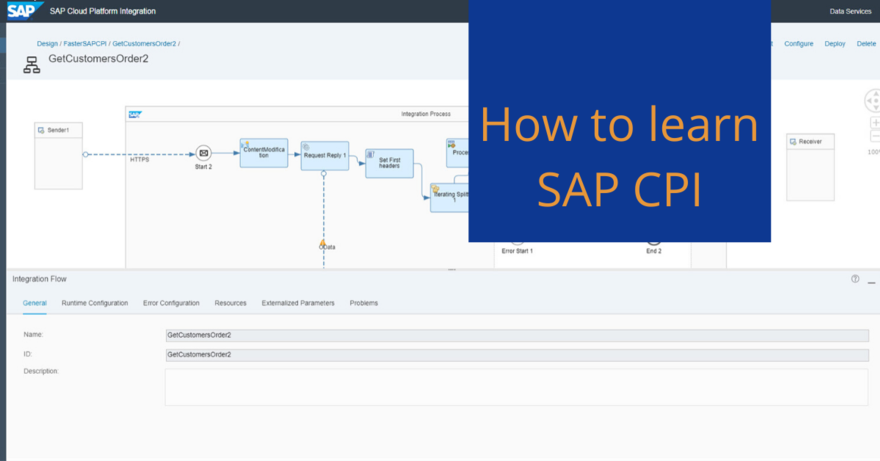SAP CPI is a complex system. There are some areas that you must understand what mean before you start creating your first real project. If not you are going to spend too much time on something that will not help your project.
I’m all for learning why creating a new project, but I have also run into challenges that I did not know how to solve properly when I started doing SAP CPI projects.
I have tried to support some developers, that did not really understand important parts of what SAP CPI was about and then started to create their own projects. It is kind of hard to help in that situation, without taking on the full project. So instead of you spending time on understand something complex then this is your guide to get started with SAP CPI.
View as video guidance.
1) Get access to SAP CPI
The first step is to get an SAP CPI tenant. If you have one in your organization, great then just get access to it. Otherwise, you can signup for the trial tenant. You can see how to in my video guide or in this blog here.
2) Understand some examples
It is useful to understand some of the patterns in place in SAP CPI. I recommend the Cloud Integration – Exemplars package gives a lot of ideas on how to solve specific challenges with SAP CPI. Copy it to your tenant and play around with it.
3) Look at some more complicated real flow provided by SAP
Understand how real flows are created. I do like the SuccessFactors to AD but there is a lot of others out there. And if you are going to work with a specific solution then try to browse some of the Iflows used there.
4) Create your first simple flow
Create a simple flow for SAP CPI to see you can deploy and run it. I an example video in my free course. You can also follow the beginner guide from SAP in the help pages. You can create your own first flow without much help if you use the free trial, for now, it is best to start with a scheduler, some content modifier and then deploy it. View the trace of it.
5) Concepts that you must understand
There are some concepts that are vital to be able to deliver and work with SAP CPI. If you don’t understand them it will be difficult to build real iflows without banging your head agest the wall. Enhance the first iflow you created to understand the following. You can also take a course or read a book to get to understand them, see section 7.
There are or sure other concepts but they will depend on what you are trying to achieve and then you can dig into them.
- The message structure used to run SAP CPI, what the difference between header, properties, and body are.
- Content Modifiers including the Camel Simple Expression to be able to simply create messages and move around with payloads. How you can save payloads in properties and retrieve them later.
- Request-Reply step to understand how you can call external services
- How to use the authentication process from SAP CPI to save oauth or username/password
- Use Local flows and Process Direct to make the flows easier to understand and modularize the CPI code
- The different flow logic like Router, Splitter, Aggregator. It makes it easier to implement code with it, so you can
- Groovy script. You don’t need to become an expert in Groovy Script. In most cases, you can handle the modifications with a few lines of java code.
- XSLT is also useful for mapping XML content if the structure needs to be different.
- External parameters that allow you to configure your integration, so you don’t need
- How you can set messages to be easier searchable in the message monitor.
- Fault handling. How you can set up alternative processing if something fails.
- Naming of objects, so no standard names are used. It will be a lot easier to understand your code then.
6) Online help
The online help page does contain a large number of useful sections about the concepts above and provides a good reference to solving the problems you run into.
7) Courses and books
I will recommend going through some formal training, to ensure you know what is going on. The thing about the training is that the instructor has made thoughts about what should be learned. I do recommend my course on CPICourse but the other option will give you other lessons at different prices.
- CPICourse.com I have created a course that gives participants an idea about the different concepts in SAP CPI so they can get started with development and architecture.
- Open SAP Course Application Integration Made Simple with SAP HANA Cloud Integration. This is a free course. This gives a good overview of what SAP CPI can do and how to design some elements. It is a little old, but it gives a good understanding of what is there. There is a new CPI Suite course that does contain some interesting segments but is at a higher level.
- SAP Training. There is the SAP Training CLD900 for SAP CPI where you get 3 days to work and learn the platform. I have not attended it.
- There is the book SAP Cloud Platform Integration: The Comprehensive Guide. I did have the first version which gave insights into how you can configure different things. It does serve as good reference material.
8) Create a real project
Now you are ready to create your own project in SAP CPI. They will probably not be easy to create and you will run into problems. It is called learning. Go thru blogs.sap.com/answers.sap.com, Exemplars package or the online help to find a solution to your problem.
Get a mentor to give you feedback on what you have developed, so you can improve it for the next project.

